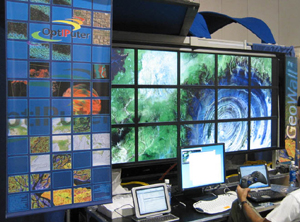OptIPuter Progress Reported
|
1.30.04 -- In a three-day meeting held in mid-January, 70 participants from Europe, across the U.S., and Japan met to discuss the OptIPuter's first year's progress and update work plans, timelines, and deliverables to National Science Foundation (NSF) for the second year.
Calit2 director and OptIPuter PI Larry Smarr, UC San Diego, began the meeting with a discussion of what the OptIPuter is and who will benefit from it. Later in the meeting members of the OptIPuter's Frontier Advisory Board refined the OptIPuter's definition to be an "environment being designed for high-performance science (i.e., big data science) that is being enabled by intelligent light paths." The goal of the project is to design a scalable system based on open source, mass market (commodity) parts that can be easily installed and customized for any lab. The project is comprised of working groups developing various subpieces, all needed for the overall infrastructure to work:
- IP over lambda connectivity. This work is led by Tom DeFanti, University of Illinois at Chicago, and Phil Papadopoulos, San Diego Supercomputer Center (SDSC).
- Middleware for the LambdaGrid, including work on network protocols, lambda grid services for real-time applications, and security. This work is led by Andrew Chien, UC San Diego.
- Visualization, collaborative environments, and data retrieval/mining. This work is led by Jason Leigh, University of Illinois at Chicago.
- Applications with large volumetric data objects that scientists want to interactively correlate and explore from the Neuroscience and Earth Science disciplines as well as education and outreach. This work is led by Mark Ellisman, UC San Diego, John Orcutt, Scripps Institution of Oceanography (SIO), and Rozeanne Steckler, SDSC.
O ptIPuter research team members come from these institutions as well as: UCI, SDSU, USC Information Sciences Institute, Northwestern, Texas A&M, University of Amsterdam, and the U.S. Geological Survey. Over the course of this half-day portion of the meeting, each group leader also provided a summary of progress to date.
The IP-over-lambda-connectivity work includes experimentation with multiple layer alternatives, uses of intelligent routers and passive switches, and control plane software for inter- and intra-domains. In partnership with the National Lambda Rail, the OptIPuter will become national-scale this fall with a 10-Gbps dedicated link between southern California and Chicago. The OptIPuter already goes "international" via StarLight from Chicago to Amsterdam. Furthermore, discussions are underway to provide a 400-mile link between UCSD with NASA Ames over the National Lambda Rail, connecting the two sites' Chiaro Networks' "Enstara" routers.
With respect to middleware, the project involves a LambdaGrid control plane paradigm shift. Traditional provider services have been based on invisible, static resources and centralized resource management. The OptIPuter project is exploring a new paradigm based on distributed devices, dynamic services, and visible and accessible resources integrated as required and on demand by the applications.
In the words of Chien, the middleware group is developing a unified vision of an applications interface to middleware, innovative transport protocols that make optimal use of high-speed optical networks, application-centric network performance tools, security models, and data-handling tools and techniques. They are working from the notion of a distributed virtual computer, a simple computing environment to support applications that leverage rich Grid resources and optical network connections that can be formed on demand. Optical Lightpath Accelerator technology from Canadian startup Big Bangwidth is being evaluated in the UCSD testbed.
Visualization is focusing on large digital montages, with emphasis on very-high-resolution imagery. The images are 2-D (such as those provided by the U.S. Geological Survey, which is mapping 133 of the largest U.S. cities at 1' resolution, which will produce 10-billion-pixel single images) or 3-D volume visualizations visualized on tiled displays (such as was demonstrated at SC03 in November). They are also working on photonic multicasting (using dedicated lambdas and photonic switches from Calient and Glimmerglass) and development of the Scalable Adaptive Graphics Environment for high-resolution, room-sized display walls.
The visualization group welcomed new members Donna Cox and Bob Patterson from UIUC/NCSA and a new driving application from the earth sciences, which focuses on oceanographic modeling. The group will use Year 2 to conduct full-scale visualization and collaboration trials to identify key system bottlenecks and usability problems with software developed in Year 1.
OptIPuter development will be driven by "decadal federal e-Science commitments," including NSF's Earthscope and ORION (Ocean Research Interactive Observatory Networks) projects and NIH's BIRN (Biomedical Informatics Research Network).
With respect to education, the first year has been spent working with teachers at the Preuss School UCSD to acquaint them with the capabilities and potential uses of the GeoWall, optically connecting Preuss to the NCMIR lab (to provide remote, interactive access to the latter's microscope), and development of curricular materials that meet both state and national standards. The University of Illinois at Chicago focuses on learning technologies teaching children about the science driving OptIPuter technology development and has been working with SIO to develop the RoomQuake project for students attending Lincoln Elementary School in Oak Park, Illinois. RoomQuake simulates earthquakes using PDAs as simulated seismometers.
The outcome of this meeting was for all group leaders to refine their sections of the OptIPuter program plan to NSF. Smarr also reminded attendees that a key opportunity to demonstrate OptIPuter accomplishments will come in September 2005 at the iGrid 2005 conference, which will be hosted by Calit2 in its new building at UCSD.


